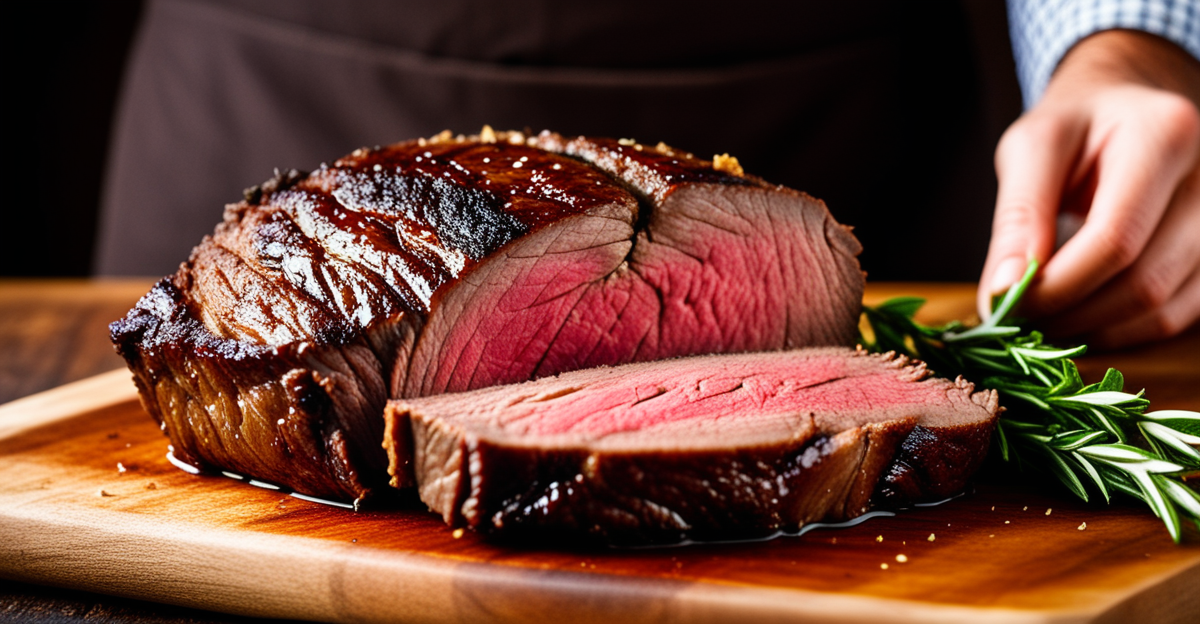Essential factors for perfect roast beef
Selecting the best cut for roast beef is foundational. Cuts like ribeye, sirloin, and tenderloin offer a balance of tenderness and flavour, making them prime choices. Understanding meat marbling, the intramuscular fat, is crucial since it melts during cooking, enhancing juiciness and richness. Well-marbled beef generally yields a more succulent roast, whereas lean cuts may require careful attention to avoid dryness.
Portion size also impacts cooking; larger roasts retain heat better and often cook more evenly. Meanwhile, fat content not only influences taste but acts as a natural baster, preserving moisture and preventing the roast beef from becoming tough. To maximize flavour and texture, consider the fat-to-lean ratio during selection.
Have you seen this : How do you create a flavorful bubble and squeak dish?
Using these roast beef basics ensures a successful start. By prioritizing high-quality cuts with ample marbling and appropriate portion sizes, you set the stage for an impressive roast. These beef roast tips guide you toward a delicious, tender result, balancing flavour and cooking practicality.
Essential factors for perfect roast beef
Selecting the best cut for roast beef is crucial for flavour and texture. Popular choices include ribeye, sirloin, and tenderloin, known for their tenderness and fat distribution. Understanding meat marbling—the intramuscular fat—is vital. Well-marbled beef melts during cooking, enriching juiciness and taste. Lesser marbling can result in drier, tougher meat.
Additional reading : What are the techniques for baking a flawless Victoria sponge cake?
Quality impacts the outcome: prime or choice grades generally have better marbling and succulence. Additionally, considering portion size affects cooking time and evenness. Larger roasts require careful temperature control to avoid uneven cooking, while smaller roasts cook faster but may dry out if overcooked.
Fat content also matters for flavour and moisture. A moderate fat cap on the roast can baste the meat naturally. Trimming too much fat leads to less flavour, but leaving excessive fat can cause flare-ups or uneven browning. Balancing these factors by choosing the right roast beef basics—cut, marbling, portion size, and fat—sets the foundation for a perfect roast every time.
Step-by-step preparation guide
Preparing roast beef starts with seasoning to enhance natural flavors. Basic roast beef seasoning usually combines salt, pepper, and sometimes garlic or herbs. This dry rub should be applied generously to all sides at least 30 minutes before cooking to allow the salt to penetrate the meat, improving moisture retention and flavour depth.
Marinating roast beef can further tenderize the meat and add complexity. Common marinades include acidic ingredients like vinegar, wine, or citrus juice combined with oil and herbs. Marinate for 2 to 6 hours in the fridge to ensure flavour infusion without breaking down the meat excessively.
Before placing the roast into the oven, it’s crucial to bring beef to room temperature—typically 30 to 60 minutes outside the fridge. This step promotes even cooking and prevents the inside from remaining undercooked while the exterior overcooks.
Lastly, prepping your roasting pan correctly sets the stage. Use a rack to elevate the beef, allowing air circulation for even heat distribution and crispier, caramelised surfaces. Lightly oil the rack or pan to prevent sticking without drowning the meat in fat.
These foundational roast beef basics streamline the cooking process, helping achieve a perfectly seasoned, well-cooked roast.
Step-by-step preparation guide
Properly preparing roast beef starts with seasoning and marinating to enhance the flavour. Marinating roast beef involves applying a mixture of herbs, spices, and acids like vinegar or citrus juice, which tenderises meat and infuses depth. For best results, marinate for at least 4 hours or overnight. When seasoning roast beef, use salt and pepper generously; these basic roast beef basics bring out natural flavours without overpowering.
Bringing the beef to room temperature before cooking is another crucial step. This practice promotes even cooking by reducing the temperature gap between the meat’s surface and its center. Typically, let the beef rest outside the fridge for 30–60 minutes depending on size.
Preparing your roasting pan properly ensures heat circulates evenly around the beef roast. Use a pan with a rack to elevate the meat, allowing hot air to reach all sides, resulting in a uniform crust. Starting with a preheated oven and placing the roast centrally further helps distribute heat.
These beef roast tips optimize flavour and texture, setting a solid foundation before cooking begins. Master these steps, and your roast beef will cook evenly, taste succulent, and carry well-rounded seasoning throughout.
Essential factors for perfect roast beef
Selecting the best cut for roast beef forms the core of successful cooking. Cuts such as ribeye, sirloin, and tenderloin are preferred because their texture and fat distribution optimise flavour and tenderness. When choosing, prioritise quality grades: prime and choice cuts generally have better marbling, an important roast beef basics element.
Meat marbling is the intramuscular fat visible within the muscle. This fat melts during cooking, boosting juiciness and enriching flavour. Insufficient marbling can lead to a drier, less tender roast. Understanding this interplay is key to executing excellent beef roast tips.
Portion size influences cooking dynamics. Larger roasts retain heat more steadily, promoting even doneness, whereas smaller roasts cook faster but risk drying if not monitored carefully. Fat content plays a dual role—not just as a flavour enhancer but also as a natural bastion against moisture loss.
Balancing these essential factors—cut, marbling, portion size, and fat—equips you with critical roast beef basics to deliver a richly flavoured, tender roast beef every time.
Essential factors for perfect roast beef
Selecting the best cut for roast beef is critical for achieving ideal texture and flavour. Cuts such as ribeye, sirloin, and tenderloin excel because of their balance between tenderness and fat content. Fat, especially the marbling within the beef, melts during roasting, enhancing juiciness and rich taste. Fat also acts as a natural bastion against drying out, making it essential to choose cuts with good intramuscular fat.
Portion size deeply influences cooking consistency. Larger roasts retain heat better and cook more evenly, while smaller roasts might dry out if overcooked. Balancing size with cooking technique ensures the beef remains tender throughout.
Fat content beyond marbling matters too. A moderate fat cap can baste the meat naturally during cooking, preserving moisture and enhancing flavour. Yet, excessive fat may hinder even browning and lead to flare-ups.
Integrating these roast beef basics—the right cut, marbling, portion size, and fat content—provides a solid foundation. Following these beef roast tips helps avoid common pitfalls like dryness or toughness. Mastering these factors is key to creating a perfectly succulent roast every time.
Essential factors for perfect roast beef
Choosing the best cut for roast beef is vital. Cuts like ribeye, sirloin, and tenderloin stand out as prime options due to their tenderness and flavour profile. When you ask, what makes one cut better than another? The answer lies in the balance of muscle and fat. The roast beef basics teach us that cuts with appropriate fat distribution and good muscle texture produce moist, flavoursome results.
Understanding meat marbling deepens this knowledge. Marbling refers to the intramuscular fat, which melts during cooking, enriching the meat’s juiciness and boosting its rich flavour. Cuts with higher marbling score higher in taste and tenderness, making this a key factor in choosing the best cut for roast beef. Leaner cuts, while healthier, require careful cooking to avoid dryness.
Portion size and fat content also impact the outcome. Larger roasts ensure more even cooking by retaining heat longer. Fat content acts as a natural bastion, preserving moisture and contributing savoury flavour. However, balance is essential; too much fat can cause uneven cooking or flare-ups, while too little risks dryness. These beef roast tips guide the selection process for a perfectly cooked roast every time.
Essential factors for perfect roast beef
Selecting the best cut for roast beef is a cornerstone to a superb result. Commonly favored cuts like ribeye, sirloin, and tenderloin excel due to their balance of tenderness and flavour, but choosing high-quality meat with good marbling is equally critical. Marbling refers to the intramuscular fat dispersed within the muscle fibers. This fat melts during cooking, imparting juiciness and enhancing flavour depth. A roast lacking sufficient marbling risks turning out dry and less tender.
Portion size significantly impacts cooking control and final texture. Larger roasts retain heat better and cook more evenly, reducing chances of dry spots, whereas smaller roasts require vigilant timing to prevent overcooking. Fat content beyond marbling also matters—a moderate fat cap serves as a natural bastion, preserving moisture and enriching taste. However, excess external fat can cause uneven browning or flare-ups.
Balancing these roast beef basics—selecting the ideal cut, understanding marbling’s flavour role, managing portion size, and adjusting fat content—forms the foundation of expert beef roast tips. Applying these principles ensures a roast beef outcome with tender texture and robust flavour consistent every time.
Essential factors for perfect roast beef
Choosing the best cut for roast beef is fundamental to achieving optimal flavour and tenderness. Cuts like ribeye, tenderloin, and sirloin consistently rank high because their fat distribution complements their muscle texture, producing moist and flavoursome results. The roast beef basics highlight that selecting the right quality grade, such as prime or choice, ensures better marbling, which is crucial.
Meat marbling refers to the fine streaks of intramuscular fat visible within the muscle fibers. This fat melts slowly during roasting, enriching the beef with juiciness and depth of flavour. Without good marbling, even the best cooking techniques may deliver a drier, less tender result. Hence, understanding marbling’s impact is central to effective beef roast tips.
Portion size also dictates cooking success. Larger roasts retain heat more evenly, reducing the risk of uneven doneness, while smaller cuts need vigilant temperature control to avoid drying out. Fat beyond marbling, such as a moderate external fat cap, naturally bastes the beef during roasting. However, excessive fat can cause uneven browning or flare-ups, so balancing fat content is essential for an ideal roast.
By mastering these key roast beef basics, you gain control over texture, flavour, and moisture, laying the groundwork for perfect roast beef every time.






